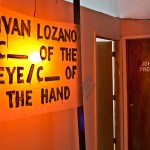C___ OF THE EYE / C___ OF THE HAND (solo show), 2012
- (installation view)
- (installation view)
- (installation view)
- (installation view)
- (installation view)
- (installation view)
- (installation view)
- (installation view)
- (installation view)
- (installation view)
- (installation view)
- (installation view)
- (installation view)
- (installation view)
- (installation view)
- (installation view)
- (installation view)
- (installation view)
- (installation view)
EXHIBITION ESSAY:
C___ OF THE EYE / C___ OF THE HAND
Johalla Projects, Chicago, IL, 2012
Eyes trade off for hands, the unseeing gaze that you can’t escape. Flattened image and the feel of your own hands replace the feel of another’s hands on your body and your hands on theirs. In Ivan LOZANO’s installation C____ OF THE EYE/ C____ OF THE HAND the dialogue between eyes and hands enacted in front of computer-screened pornography becomes a metaphor for two sides of the artistic process: looking and acting; seeing and responding.
LOZANO conceived his installation in relation to Johalla Project’s architecture. With its long nave intersected by a transept, the gallery is laid out on the same plan that Catholic basilicas have used since first century AD. LOZANO evokes such associations in his treatise on sex-magick, a spiritual practice where orgasm makes the body transcendent and is the launching pad for the manifestation of will. Using sex-magick as a framework, LOZANO probes the questions of what seeing means and what is essential to it.
An altar sits at the far end of the gallery, sited where it would be placed in a church.
However, the crucified Christ is replaced with a hydra-headed porn star, falling backwards in orgasmic pleasure. A television equipped with a video camera is trained on the apse, creating a closed circuit loop that recalls Bruce Nauman’s studies on alienation. The camera is the eye that doesn’t get tired, never losing focus, allowing the responsibility of seeing to be divorced from the constraints of the artist’s body. And in the context of the altar, it occupies the position of omniscient divine. LOZANO literalizes the mind-body split and creates an effect of an out-of-body experience. Despite the transparency with which the apparatus is displayed, Lozano succeeds in alienating us as viewers from our own image, and thus reactivates the mysticism of technology.
Milagros and ex-votos, hand-made folk images and objects made with the intention of addressing a physical or spiritual ailment, decorate the gallery as they do at the Cathedral in the Mexican city of Guadalajara, LOZANO’s hometown. Eyes and hands can be found throughout these objects: eyes inserted into candles and resin-casts of the artist’s surgically reconstructed fist. Replacing the images of saints are photographs of porn stars. LOZANO has removed the pigment from the images of their eyes, which remain sightless despite their insistent stares. References to the ecstasies of bondage and the brutalities of torture coexist within the same image.
Between the two ends, Lozano displays his version of the Stations of the Cross. The faces of more porn stars, their faces strained in pleasure, replace the scenes from Christ’s Passions. These images were produced through a process that began when a pornographer enlisted actors and choreographed a series of sexual acts. Therefore these images have entered digital consciousness via a series of translations from one format into another: celluloid to VHS and CD to information online. After finding an image, Lozano downloads it and prints it out, making the image an object again, before photographing it and returning it to the archive. Through this process, like the enacting of any ritual, Lozano creates grace.
Rather than occupying an antagonistic relationship to the each other, the technologically divine altar and the handcrafted miracles reinforce each other. The camera’s monocular vision finds its counterpart and an Oedipal corollary in the refracted intuitive sense of the sightless community of porn stars. Lozano maps out a techno-spiritual process in the altar, and then attempts to recreate the apparent “magic” of the television in the folk objects using readily available materials. This process of transubstantiation from object to image and back again is all an effort towards reanimating and breathing life back into the flattened image, accessible only to eyes and estranged from hands.
Risa Puleo
Assistant Curator at the Blanton Museum of Art
University of Texas at Austin




















